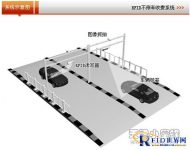
The Application of RFID Technology in Freeway Toll Collection System
[ad_1]
I. Overview
useRFIDIn the application of automatic highway toll collection technology, it can reflect the advantages of RFID. Instead of the original manual and computer-assisted charging system, the low-efficiency toll collection system uses RFID’s long-distance and rapid identification feature. Vehicles can pass through at high speed and complete automatic charging, which solves the original high cost of charging, management confusion and traffic congestion caused by parking queues. And other issues. Practice has proved that most RFID systems are safe, stable and reliable, and can achieve due social and economic benefits.

2. Background
ETC (Electronic Toll Collection) is abbreviated as Electronic Toll Collection. It refers to the realization of vehicle identification and information writing (entry) through on-board equipment when vehicles pass through toll stations. The deduction of the corresponding funds (export) from the bank account is an electronic toll collection system for roads, bridges and tunnels that is being developed and popularized internationally. However, there are many problems, such as: • Manual toll collection or computer-assisted toll collection, manual identification, long charging time, unsupervised fee calculation, and slow vehicle traffic. • Toll collection facilities are outdated, and toll stations at the entrance of the city form a traffic bottleneck, creating a bad image. • Vehicles pass slowly, stop frequently, and the pollution of car exhaust to the environment increases.
Three, system design
The key technology of the non-stop toll collection system mainly focuses on automatic identificationRFIDElectronic tags, barrier-free access, real-time monitoring, efficient and accurate management. The system consists of a computer, management software, RFID electronic tags, RFID electronic tag readers, control boxes, barriers and ground sensing coils. The system can realize functions such as automatic inspection, registration, and release. Each car puts an RFID electronic tag (the size of a bank card) in the windshield to record the basic information of the car, and installs an RFID electronic tag reader at the entrance and exit of the crossing, and is equipped with a barrier and a ground coil.When a vehicle with an RFID electronic tag enters the ground induction coil, the ground induction coil gets a signal, and at the same timeRFIDThe reader also reads the signal of the RFID electronic tag, and the optical recognition system recognizes the license plate of the car. If it is legal, it sends a signal to open the barrier and allow the vehicle to pass. In addition, the automatic identification system reads the user’s fee information, model information, and entrance lane information in the electronic tag to calculate the toll, and displays the information about the charging status to the user and then releases it. If an illegal user forcibly passes through a dedicated lane, the license plate can be snapped to generate a violation record, which is convenient for post-processing. At this time, as long as the vehicle decelerates appropriately, does not need to stop, and does not need to reach out and swipe the card, it can pass the crossing smoothly.



4. System functions and advantages:
1. Automatic recognition, no need to stop
useRFIDThe application of technology in the expressway non-stop toll collection system, using the feature of RFID long-distance automatic identification, can communicate without interfering with each other, so that the tags can communicate reliably within a limited power range, and increase the stability of the system. As long as you slow down properly, you don’t need to stop, or you don’t need to reach out and swipe your card, you can pass the crossing smoothly.
2. Information file management
useRFIDThe unique ID nature of the electronic tag is bound to the back-end database. All information, including user information, charging information, vehicle traffic conditions, etc., will be recorded and formed into an information file. And the toll station can communicate with the toll management center through the communication network and the toll sub-center to facilitate the management and maintenance of the account information drawn by the electronic tag.
3. Statistical graph analysis
The system provides various statistical analysis reports and charts based on records and statistical information. The toll management center can connect various toll stations through the network for data exchange and management. The management center checks some payment status, entry status, and traffic flow of various road sections. Summarize all data, archive, store, and print various reports.
4. Traffic supervision and management
The networked system guarantees the timely delivery and update of information. Under normal network conditions, the road section control center can timely transmit the black and gray list defined by the system to the entrances and exits of various toll stations, and implement warning prompts for vehicles in arrears, and for illegal vehicles. Perform operations such as interception, capture or alarm. Various rate tables can be issued to various toll stations in time, and the dynamic information of the entire road network can be understood in time, and congestion or other abnormal conditions of the road network can be discovered in time.
5. Environmental protection and energy saving, creating a better image
useRFIDThe technology realizes non-stop passing, which has changed the traditional way of slow vehicle traffic, many parking times, and increased environmental pollution caused by vehicle exhaust. More energy saving and environmental protection, so that toll stations will also receive good social evaluation, and improve social and economic benefits.
[ad_2]


